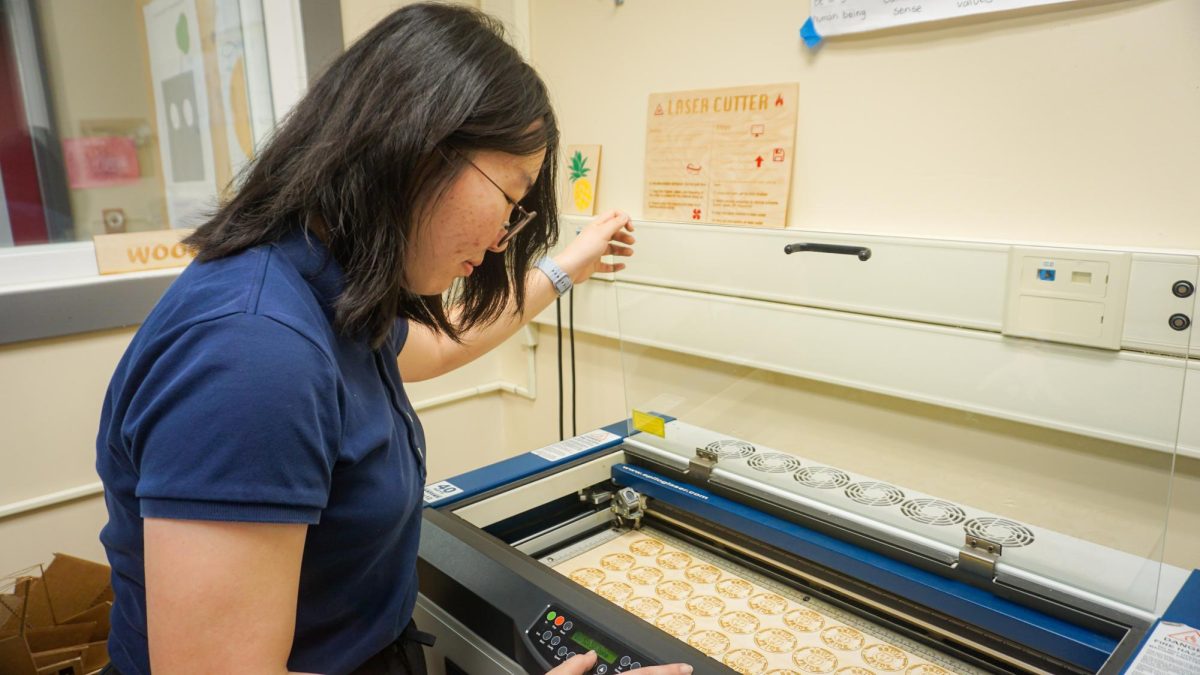Science, Technology, Engineering and Mathematics are the cornerstones of the 49ers STEM Leadership Institute program. One of the resources available to them is the SCHS Fab Lab. The common consensus has been that the Fab Lab is a space reserved only for current STEM students. While there are, according to Fab Lab Program and Technology Manager Laurie Toyama, limiting factors, students that are not in the SLI program are still able to learn and navigate the tools in the Fab Lab.
The Fab Lab is home to many different tools and machines that students use, including a 3D printer, a laser cutter and more. In order to utilize the machines, Toyama emphasized taking an important first step to bringing one’s own idea to life.
“Everything in here starts with a CAD tool,” Toyama said. “You have to be able to design something in a computer aided design tour because you can’t just go to a machine. You have to give it a digital design.”
CAD stands for Computer-Aided Design. It is a program in which students use computer programs to create designs that are then transferred over to the machines in the Fab Lab. Most students in the SLI program are already familiar and equipped with the knowledge of how to use the CAD programs.
Toyama understands that not everyone knows what a CAD program is and the importance of utilizing such programs to properly operate the machines in the Fab Lab. Recognizing this as a limiting factor, Toyama offered avenues students can take to learn how to use the programs.
“There are actually free programs all over the place,” Toyama said. “Tinkercad is free. It’s web based, so you don’t need to download anything.”
STEM introduces its students to the different tools and machinery available in the Fab Lab, preparing them to properly use the equipment in the lab. SLI student junior Jean Yoo understands the general concern of allowing anyone in the Fab Lab.
“If we have a lot of non-STEM kids in there, there’s that fear that they’re going to touch the machines and possibly get hurt, or injure some of the materials,” Yoo said.
Senior Ruchi Alavilli has utilized the Fab Lab for many of her STEM projects, taking advantage of the materials paid for by the SLI program. According to Alavilli, one of the main deterrents for many non-STEM students are the materials themselves.
“Whenever I’ve asked the staff members if my friends could use the Fab Lab for personal projects, it’s always, ‘Yes,’” Alavilli said. “But they have to pay for the materials inside.”
Alavilli recognized a privilege that SLI students tend to overlook: the price tag. Costs add up creating many iterations for a project that consumes more materials than anticipated.
“You have to think about the cost of materials for everything, which isn’t what you normally worry about as a STEM student,” Alavilli said.
Sophomore Dhruva Kotikalapudi experienced little space and availability in the Fab Lab. As an SLI student, he found it difficult to move around the Fab Lab as the area was packed with non-STEM students.
“Towards the last couple weeks, it’s always crunch time. There’s a lot of mass production happening, and in those times, it’s usually crowded,” Kotikalapudi said. “Same with the tutorials, there’s such a fat bottleneck.”
According to sophomore Meena Swaminathan, a student in the SLI program, accessing the Fab Lab can expose students to important information for their education. For those not in the STEM program, it provides opportunities they usually may not have otherwise.
“Even if you’re not in the STEM program – which is very selective, and people in the older grades can’t apply after freshman year – I think everyone should be able to use the Fab Lab and know these skills because they’re important in the workforce,” Swaminathan said.
As mentioned by Toyama, the free online CAD programs have opened up avenues for students to start learning how to use the machines. That is where the willingness to learn comes in, an aspect that Yoo finds to be important to using the equipment in the Fab Lab.
“I would honestly love it if the Fab Lab were to be able to open its machines to non-STEM kids who are able to show that they can use the machines responsibly,” Yoo said.
Creating a welcoming space for those interested in utilizing the tools in the Fab Lab is a notion that Yoo hopes can be emphasized by the school, opening the door to new opportunities for every student in the future.
“I would absolutely love it if other non-STEM students were able to come in and use those machines,” Yoo said. “I think it’s a missed opportunity that SCHS should really be looking into.”


